| Revision as of 06:47, 8 September 2009 editRacepacket (talk | contribs)16,693 edits rearrange← Previous edit | Revision as of 06:47, 8 September 2009 edit undoRyulong (talk | contribs)218,132 edits →History: Suntan U stuffNext edit → | ||
| Line 66: | Line 66: | ||
| In 2006, the ] for two months prompting demonstrations on campus.<ref>{{cite news|url=http://www.miami.com/mld/miamiherald/14433014.htm|work=Miami Herald|date=April 26, 2006|first=Ana |last=Menèndez|title=AT UM TENT CITY AMONG THE TREES, HOPE RESOUNDS|page=B1}}</ref> | In 2006, the ] for two months prompting demonstrations on campus.<ref>{{cite news|url=http://www.miami.com/mld/miamiherald/14433014.htm|work=Miami Herald|date=April 26, 2006|first=Ana |last=Menèndez|title=AT UM TENT CITY AMONG THE TREES, HOPE RESOUNDS|page=B1}}</ref> | ||
| <ref>{{cite news |url=http://www.miami.com/mld/miamiherald/news/opinion/14438159.htm|work= Miami Herald|title=The Janitor's Fight|page=30A|date=April 27, 2006}}</ref> | <ref>{{cite news |url=http://www.miami.com/mld/miamiherald/news/opinion/14438159.htm|work= Miami Herald|title=The Janitor's Fight|page=30A|date=April 27, 2006}}</ref> | ||
| Since its inception, UM has been fighting being called "Suntan U" due to its location and the party atmosphere of the city of Miami. In 1961, it awarded its first doctorate degrees and built new libraries, dormitories, symphony rehearsal halls, and classroom buildings.<ref>{{cite web|url=http://www.time.com/time/magazine/article/0,9171,894532,00.html|title=Education: Growing Up in Miami - TIME|accessdate=2009-09-08|date=1961-06-23}}</ref> Shalala fights this dubious nickname by bringing in multitalented students to improve the academics of the university.<ref>{{cite web|url=http://articles.latimes.com/2003/jan/03/nation/na-miami3|title='Suntan U' Tries to Shed Cushy Image - Los Angeles Times|accessdate=2009-09-08|date=2003-01-03}}</ref> | |||
| ==Campus== | ==Campus== | ||
Revision as of 06:47, 8 September 2009
This article is about the university in Coral Gables, Florida. For the university in Oxford, Ohio, see Miami University.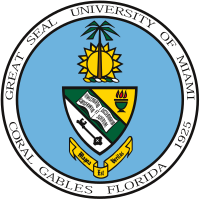 | |
| Motto | Magna est veritas (Latin) |
|---|---|
| Motto in English | Great is the truth |
| Type | Private |
| Established | 1925 |
| Endowment | $736 million USD |
| President | Donna Shalala |
| Academic staff | 2,348 |
| Students | 15,449 |
| Undergraduates | 10,379 |
| Postgraduates | 5,070 |
| Location | Coral Gables, Florida, USA Miami, Florida |
| Campus | Suburban |
| Colors | Orange, Green and White |
| Nickname | Hurricanes |
| Mascot | Sebastian the Ibis |
| Website | www.miami.edu |
| File:Umiami prime logo.svg | |
The University of Miami (commonly referred to as UM, or Miami of Florida, or The U) is a private, non-sectarian university founded in 1925 in the city of Coral Gables, Florida, a historic suburb of Miami. The Miller School of Medicine and various other departments are located in Miami proper at the Miami Civic Center and on Virginia Key.
The university currently enrolls 15,323 students in approximately 115 undergraduate, 114 master’s, 51 doctoral, and two professional areas of study. The University's students represent all 50 states and 148 foreign countries. With more than 13,000 full and part-time faculty and staff, UM is the largest private employer in Miami-Dade County.
History
The University of Miami was chartered in 1925 by a group of citizens who believed an institution of higher learning was needed for the development of their young and growing community. The South Florida land boom was at its peak, resources appeared ample, optimism flowed, and expectations were high. Supporters of the institution believed that the community offered unique opportunities to develop inter-American studies, to further creative work in the arts and letters, and to conduct teaching and research programs in tropical studies.
The University began in earnest in 1926 when George E. Merrick gifted 160 acres (0.6 km) and nearly $4 million dollars to the effort. By the fall of that year, when the first class of 560 students enrolled at the University of Miami, the land boom had collapsed, and hopes for a speedy recovery were dashed by a major hurricane. In the next 15 years the University barely kept afloat. The construction of the first building on campus, now known as the Merrick Building, was put on hold for over two decades due to economic hard times. In the meantime, classes were held at the nearby Anastasia Hotel, with partitions separating classrooms, giving the University the short-lived nickname of "Cardboard College." The University survived early turmoil during the leadership of its first president Bowman Foster Ashe (1926-1952). During his presidency, the University added the School of Law (1928), the School of Business Administration (1929), the School of Education (1929), the Graduate School (1941), the Rosenstiel School of Marine and Atmospheric Science (1943), the School of Engineering (1947), and the School of Medicine (1952).
One of Ashe's longtime assistants, Jay F. W. Pearson, assumed the presidency in 1952. A charter faculty member and a marine biologist by trade, Pearson ushered in a decade of unprecedented growth for the University. Enrollment increased by more than 4,000 during his tenure, which ended in 1962.
From 1961 to 1968, Miami leased buildings on its South Campus to serve as the covert headquarters of the Central Intelligence Agency's JMWAVE operation against Fidel Castro's government in Cuba. In 1968, after Ramparts magazine exposed CIA operations on other campuses, JMWAVE was moved off the Miami campus out of concern for embarassing the university.
Henry King Stanford became Miami's 3rd president in 1962. The Stanford presidency saw increased emphasis on research, reorganization of administrative structure and construction of new facilities. Among the new research centers established were the Center for Advanced International Studies (1964), the Institute of Molecular and Cellular Evolution (1964), the Center for Theoretical Studies (1965), and the Institute for the Study of Aging (1975).
In 1981, Edward T. Foote II became the school's fourth president. Under Foote's leadership, on campus student housing was converted into a system of residential colleges. In addition, Foote initiated a five year $400 million fund raising campaign that began in 1984 and surpassed its goal with a $517.5 million dollar commitment.
Foote was succeeded by Donna Shalala, who assumed the presidency in 2001. Shalala served in the Clinton Administration as Secretary of Health and Human Services from 1993-2001, becoming the longest serving HHS Secretary in U.S. history. She was awarded the Presidential Medal of Freedom, the nation's highest civilian honor, by President George W. Bush in June 2008.
In 2003, the university lanuched a fund raising drive which grew its endowment to the point that it ranks 97th in size in the nation.
In 2004, UM's BankUnited Center (formerly the Convocation Center) was the site of the first nationally televised U.S. presidential debate of the 2004 U.S. Presidential election, featuring President George W. Bush and U.S. Senator John Kerry.
In 2006, the custodial works on campus struck for two months prompting demonstrations on campus.
Since its inception, UM has been fighting being called "Suntan U" due to its location and the party atmosphere of the city of Miami. In 1961, it awarded its first doctorate degrees and built new libraries, dormitories, symphony rehearsal halls, and classroom buildings. Shalala fights this dubious nickname by bringing in multitalented students to improve the academics of the university.
Campus
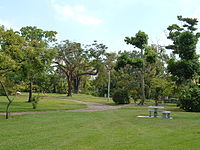
Miami's main campus spans 260 acres (1 km²) in Coral Gables, a suburb located immediately south of the city of Miami. Most of the University of Miami's academic programs are located on the main campus in Coral Gables, which houses seven schools and two colleges including the University of Miami School of Law. A few graduate and undergraduate programs are located off the Coral Gables campus. Several university satellite campuses are located off the primary campus, including the Rosenstiel School of Marine and Atmospheric Science (located on Virginia Key in Biscayne Bay) and the Leonard M. Miller School of Medicine (located at Jackson Memorial Medical Center in downtown Miami). Several other programs, including bilingual Continuing and International Education classes, are offered at the Koubek Center in Miami's Little Havana, the James L. Knight Center in downtown Miami, and the South and Richmond campuses in southwest Miami-Dade county.
The university also has a campus theater, the Jerry Herman Ring Theatre, which is used for student plays and musicals. A campus arboretum and botanical garden, the John C. Gifford Arboretum, is located on the northwest corner of the main campus in Coral Gables.
Student housing
There are five residential colleges at UM, one apartment area and the University Village.
| UM residence halls | Year built | Room capacity |
|---|---|---|
| Apartment Area | 1948 | est. 500 |
| Eaton Residential College | 1954 | 400 |
| Mahoney Residential College | 1958 | 750 |
| Pearson Residential College | 1962 | 750 |
| Hecht Residential College | 1968 | 900 |
| Stanford Residential College | 1968 | 900 |
| University Village | 2006 | 800 |
| Total | 5,000 students | |
South Campus
In 1946, Miami acquired the former Richmond Naval Air Station, in southwestern Miami, located 12 miles south of the main campus in order to accommodate the post-war increase in students. For two years the South Campus provided housing, dining and recreational facilities and classrooms for about 1100 students, mainly freshmen. From 1948 to present it has been used as a research facility and storage area. Buidings currently house: the Global Public Health Research Group, Miami Institute for Human Genomics, D.U.I. Laboratory, and Microbiology & Immunology. In the 1960s, some of the buildings were leased to the Central Intelligence Agency. The South Campus Grove is a 350-acre plot for agricultural research and hotricultural studies that was established in 1948.
The Richmond campus, established in 2001, is a 76-acre site near South Campus. The Rosenstiel School’s Center for Southeastern Tropical Advanced Remote Sensing (CSTARS) and Richmond Satellite Operations Center (RSOC) have research facilities located on a portion of the new campus.
Student body
| Ethnic enrollment, 2008 | Undergraduates | Graduates |
|---|---|---|
| African American | 10% | 7% |
| Asian American | 7% | 13% |
| Hispanic (of any race) | 28% | 22% |
| White (non-Hispanic) | 55% | 58% |
| Total | 100% | 100% |
There were nearly 20,000 applications for 2,000 slots in the fall 2008 freshman class. The mean SAT scores and high school GPAs for entering freshmen were the highest ever.
As of 2007, the university has a total student body of 15,449. In 2008, the average weighted grade point average for students granted admission to the university was 4.2 and the average SAT score was 1282. Sixty-six percent of UM students ranked in the top 10% of their high school class. As of the 2008–09 academic school year, UM's undergraduate tuition (excluding room and board) is $34,834 per year.
Academics
There are currently 2,348 full-time faculty members whose ranks include at least one Fulbright Scholar, Guggenheim Fellow, and National Science Foundation award recipient. Ninety-seven percent of the faculty hold doctorates or terminal degrees in their field.
The University of Miami is accredited by the Southern Association of Colleges and Schools and 23 additional professional and educational accrediting agencies. It is a member of the American Association of University Women, the American Council on Education, the American Council of Learned Societies, the Association of American Colleges, the Florida Association of Colleges and Universities, and the National Association of Independent Colleges and Universities.
Rankings
| 2008 | 2007 | 2006 | 2005 | |
|---|---|---|---|---|
| Applicants | 21,774 | 19,807 | 19,031 | 18,810 |
| Admits | 8,411 | 7,527 | 7,704 | 8,678 |
| % Admitted | 38.6 | 38.0 | 40.4 | 46.1 |
| This table does not account deferred applications or other unique situations. | ||||
In the 2010 issue of U.S. News & World Report's "America's Best Colleges," the University of Miami was ranked 50th among all national universities. U.S. News & World Report's 2008 ranking of U.S. medical schools ranks the Leonard M. Miller School of Medicine as the 52nd best medical school in the nation. U.S. News & World Report's 2009 ranking of U.S. law schools ranks the School of Law as the 71st best law school in the nation.
In 2008, for the fifth year in a row, the University of Miami's Bascom Palmer Eye Institute was ranked the best hospital in the country for ophthalmology in the 19th annual survey of "America's Best Hospitals," published by U.S. News & World Report. Three other specialties at the University of Miami's Jackson Memorial Hospital, geriatric care, neurology/neurosurgery and otolaryngology, are also ranked among the nation's best. The School of Medicine ranks 45th among U.S. medical centers in research funding.
A 2009 U.S. News & World Report survey of deans and senior faculty of music schools ranks the University of Miami School of Music masters programs one of the top twenty-five in the nation, and ranks the school's jazz program the second best such program in the nation.
U.S. News & World Report ranks the School of Education's graduate program as the 45th best in the nation and the Earth Sciences graduate program as the 43rd best such program in the nation.
In the 2009 edition of Best 371 Colleges, The Princeton Review ranks Miami as among the 141 "Best Southeastern Colleges" and ranks it 1st in the nation in its "Lots of Race/Class Interaction" category.
BusinessWeek includes the School of Business Administration in its ranking of U.S. collegiate business programs, ranking Miami as the 50th out of 51 U.S. undergraduate business programs in the nation. BusinessWeek also ranks Miami's full time MBA program as being in its third tier (with 45 schools in the first two tiers.) The Wall Street Journal, 2007, ranked the School of Business Administration 16th in its regional ranking category, based on interviews with corporate recruiters. The school did not place in the national or international ranking categories.
The Financial Times ranks the University of Miami MBA program as 98th in MBA programs worldwide.
The Executive MBA (EMBA) program at the University of Miami School of Business Administration, in 2008, was ranked the best Executive MBA program among all Florida colleges and universities in the Financial Times' annual EMBA rankings. The University of Miami's EMBA program is ranked 33rd among all such programs in North and South America and 76th among all EMBA programs worldwide. The research ranking of the UM School of Business Administration, which is a measure of the caliber of its faculty, is ranked 31st among all programs worldwide.
According to the 2008 Philosophical Gourmet Report, UM has the 32nd best graduate program in philosophy in the nation.
The University of Miami reported that its business, law, and medical schools all hold top rankings in Hispanic Business magazine’s lists of top ten schools for hispanics. The School of Business Administration ranks fourth on its list of top business schools in the nation, while the Miller School of Medicine ranks third on the list of all medical schools and UM’s School of Law ranks second in the nation among all law schools. The rankings are based on questionnaires sent in by the schools, reporting on enrollment, percentage of Hispanic faculty, the number of programs that recruit Hispanic students, retention rates, and student services.
Organization
| School | Tuition | Total Cost |
|---|---|---|
| Undergraduate | $35,540 | $52,044 |
| Graduate School | $26,640 | $44,968 |
| Law School | $37,418 | $54,022 |
| Medical School (FL) | $29,289 | |
| Medical School (non-FL) | $38,504 |
A partnership with nearby Florida International University also allow students from both schools to take graduate classes at either university, allowing graduate students to take a wider variety of courses.
- Undergraduate & Graduate
- School of Architecture
- College of Arts and Sciences
- School of Business Administration
- School of Communication
- School of Education
- College of Engineering
- Rosenstiel School of Marine and Atmospheric Science
- Phillip and Patricia Frost School of Music
- School of Nursing and Health Studies
- Graduate only
- The Graduate School
- Leonard M. Miller School of Medicine
- University of Miami School of Law
In addition to the above UM also has a Division of Continuing and International Education and a program in Executive Education as part of the School of Business Administration.
The Graduate School does not have a separate faculty, but rather coordinates the faculties from the other schools and colleges with respect to master and doctorate degree program.
On December 1, 2007, the University purchased the Cedars Medical Center and renamed it the University of Miami Hospital. The hospital is located in the Miami Health District, across the street from the Miller School campus and near Jackson Memorial Hospital, where UM faculty-physicians and students have been caring for patients for more than a half century.
The Department of Community Service, staffed by volunteer medical students and physicians from UM's Leonard M. School of Medicine, provides free medical and other community services in Miami and surrounding communities.
Research
Sponsored research expenditures for fiscal year 2008 reached a record of more than $326 million.
In 2009, the John P. Hussman Institute of Human Genomics, which focuses on the genetic origins of multiple sclerosis, Alzheimer’s, cancer, and other diseases in an effort to change the way medicine is practiced, opened on the University’s South Campus. The institute is supported by an $80 million matching grant from the State of Florida as well as private donations.
Libraries
The University of Miami Libraries rank among the top research libraries in North America. The Otto G. Richter Library, the University of Miami's main library, houses collections that serve the arts, architecture, humanities, social sciences, and the sciences. It is a depository for federal and state government publications. Rare books, maps, manuscript collections, and the University of Miami Archives are housed in the Special Collections Division and in the Cuban Heritage Collection.
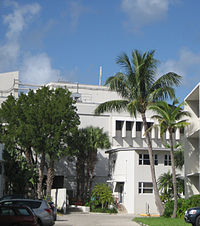
In addition to the Richter Library, the Libraries include facilities that support programs in architecture, business, marine science, and music:
- Judi Prokop Newman Information Resources Center (Business)
- Marta and Austin Weeks Music Library
- Paul Buisson Reference Library (Architecture)
- Rosenstiel School of Marine and Atmospheric Science Library
The University also has specialized libraries for medicine and law:
- Louis Calder Memorial Library (Medicine)
- University of Miami Law Library
Within the Miller School of Medicine, there are two specialized departmental libraries for ophthalmology and psychiatry that are open to the public:
- Mary and Edward Norton Library (Ophthalmology)
- Pomerance Library (Psychiatry)
Combined holdings of the libraries include over 3.1 million volumes, 15,375 print serial subscriptions, 4 million microforms, and access to more than 42,800 e-journals and 479,000 e-books and databases.
Student life and activities
The University is affiliated with 31 fraternities and sororities. Student organizations include service groups such as Amnesty International and Habitat for Humanity; religious-, ethnic- , and nationality-based affinity groups; professional and pre-professional organizations, including the Ad Group and American Society of Civil Engineers; hobby groups such as the Sailing Hurricanes and UM Film/Theater Club; and task-based groups such as the Ibis yearbook, UMTV, WVUM-FM.
Since 1929, students have published The Miami Hurricane newspaper twice a week. The paper has been honored in the Associated Collegiate Press Hall of Fame.
Miami has a honor society for seniors and graduate students called the Iron Arrow Honor Society.
Athletics
Main articles: Miami Hurricanes, Miami Hurricanes baseball, and Miami Hurricanes football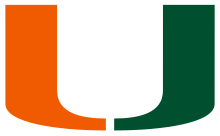
The university fields 15 athletic teams. Men's teams compete in football, baseball, basketball, cross-country, diving, tennis, and track and field. Women's teams compete in basketball, cross-country, diving, golf, rowing, soccer, swimming, tennis, track and field, and volleyball.
The university's sports teams are nicknamed the "Hurricanes" and compete in the Atlantic Coast Conference. The university is particularly well known for having one of the most successful Division I collegiate football programs of the past three decades, winning more national championships during this period (1983, 1987, 1989, 1991, and 2001) than any other program. They are known for their football team's close relationship with the NFL, often sending many players into the NFL Draft each year. The team was a mainstay in the AP Top 25 for three decades during the 1980s, 1990s and early 2000s.
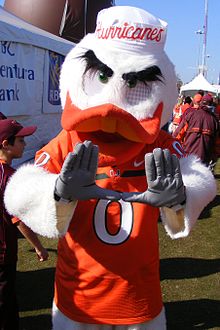
The school colors are orange, green and white, representing the fruit, leaves, and blossoms of the orange tree. The school mascot is Sebastian the Ibis. The ibis was selected as the school's mascot because, according to university legend, it is the last animal to flee an approaching hurricane and the first to reappear after the storm, making it a symbol of leadership and courage. The school's athletics logo is a simple orange and green split-letter "U" (orange on the left, green on the right). Nike is the official supplier of uniforms, apparel, and various athletic equipment to all University of Miami sports teams.
Until 2007, the University of Miami played its home football games at the historic Orange Bowl, in the Little Havana neighborhood of Miami. The university refused to renew a contract with the Orange Bowl, and the stadium was torn down in late 2007. In 2008, the University of Miami began playing its home games at LandShark Stadium (recently renamed from Dolphin Stadium) in Miami Gardens; the university has signed a 25-year contract to play there through 2033. A smaller facility, Cobb Stadium, is located on the University of Miami campus and is used by the university's women's soccer and men's and women's track and field teams. UM's men's and women's basketball teams play their home games at BankUnited Center on the Coral Gables campus.
Their traditional athletic rivals include the Florida State University Seminoles and the University of Florida Gators. Since 1987, however, the Hurricanes have only played the Florida Gators four times on the gridiron (three times during the regular season and once for a bowl game in the 2004 Peach Bowl).
Notable alumni
Main article: List of University of Miami alumniNotable faculty
Main article: List of University of Miami facultySee also
- Custodial workers' strike (2006) – University of Miami custodial workers voted to strike, citing unfair labor practices, substandard pay, and lack of benefits.
- Independent Colleges and Universities of Florida
- JMWAVE – a major center for CIA operations against Fidel Castro's Cuba, based at the University of Miami in the 1960s.
References
- ^ ""NACUBO Endowment Study"" (PDF). Retrieved 2009-01-28.
- "About the University of Miami". Retrieved 2007-04-26.
- "ESPN.com: Miami (FL) Hurricanes Football Clubhouse". Retrieved 2007-04-26.
- "DefenseLink News Article: America Supports You: University of Miami 'Adopts' Sailors in Iraq". Retrieved 2007-04-26.
InsideTheU.com The #1 Source on the Miami Hurricanes and Recruiting
Eye on the U
"President Shalala at "Spirit of the U" CD recording session | University of Miami". 2007-04-24. Retrieved 2009-09-06. - "Achievements and Traditions | University of Miami". Retrieved 2009-09-08.
- "Student Enrollment — Fall 2008 | University of Miami". Retrieved 2009-09-05.
- "University of Miami's Economic Impact Grows to $3.9 Billion | University of Miami". 2005-08-23. Retrieved 2009-09-07.
- Bohning, Don (2005). The Castro Obsession: U.S. Covert Operations in Cuba, 1959-1965. Potomac Books Inc. p. 79. ISBN 978-1574886757.
- Bohning, Don (2005). The Castro Obsession: U.S. Covert Operations in Cuba, 1959-1965. Potomac Books Inc. p. 253. ISBN 978-1574886757.
- "President Donna E. Shalala's Biography". Retrieved 2009-02-01.
- "UM President Donna E. Shalala Receives Presidential Medal of Freedom, Nation's Highest Civilian Award". Retrieved 2008-06-10.
- Menèndez, Ana (April 26, 2006). "AT UM TENT CITY AMONG THE TREES, HOPE RESOUNDS". Miami Herald. p. B1.
- "The Janitor's Fight". Miami Herald. April 27, 2006. p. 30A.
- "Education: Growing Up in Miami - TIME". 1961-06-23. Retrieved 2009-09-08.
- "'Suntan U' Tries to Shed Cushy Image - Los Angeles Times". 2003-01-03. Retrieved 2009-09-08.
- "UM Housing". UM Department of Residence Halls. Retrieved 2008-02-26.
- "Phonebook | University of Miami". Retrieved 2009-09-07.
- "Display Selected University of Miami Legacy Images". Retrieved 2009-09-07.
- "University of Miami 101: facts and figures". Retrieved 2009-09-07.
- "Enrollment Summary, Fall 2008". UM enrollment facts. Retrieved 2008-11-17.
- "Best Colleges 2009," U.S. News and World Report, August 2008.
- ""Fast Facts"". Retrieved 2008-08-07.
- ""Best Colleges 2009"". Retrieved 2008-08-22.
- "Profile of Admitted Freshmen Fall 2008". Official site. Retrieved 2008-11-17.
- "USNews.com: America's Best Colleges 2009: National Universities Rankings". Retrieved 2008-08-22.
- "USNews.com: Graduate School: University of Miami (Law): At a glance". Retrieved 2006-10-19.
- "UM's achievements in 2007-2008". Retrieved 2009-01-21.
- "Research Rankings: Best Medical Schools". US News & World Report. Retrieved 2009-09-06.
- "A Little History". Retrieved 2009-01-31.
- "Best Graduate Schools - School of Eduction". Retrieved 2009-01-31.
- "Best Graduate Schools - Earth Sciences". Retrieved 2009-01-31.
- "Best Southeastern Colleges". Retrieved 2009-09-08.
- "UM Featured in Princeton Review's "The Best 371 Colleges"". Retrieved 2009-09-07.
- "Princeton Review: University of Miami". Retrieved 2006-10-30.
- "Princeton Review: University of Miami". Retrieved 2009-09-08.
- "The Top Undergraduate Business Programs". Retrieved 2006-10-19.
- "Business School Rankings & Profiles". Retrieved 2009-09-07.
- "Recruiters' Scorecard" (PDF). Retrieved 2009-09-08.
- "Global MBA Rankings 2009". Retrieved 2009-09-07.
- "Business school rankings and MBA rankings from the Financial Times". Retrieved 2009-09-06.
- "University of Miami Executive MBA Program Ranked No. 1 in Florida; School of Business Also Earns Top Research Ranking". Retrieved 2008-10-27.
- "The Philosophical Gourmet Report". Retrieved 2009-01-31.
- "Diversity report: Hispanic Business Magazine ranks three UM schools in top ten". Retrieved 2009-09-08.
- "2009 - 2010 Tuition & Fees, Room & Board" (pdf). Retrieved 2009-09-08.
- "2009-2010 Cost of Attendance (Continuing Undergraduate) | University of Miami". Retrieved 2009-09-08.
- "UMMSM: Office Of Financial Assistance". Retrieved 2009-09-08.
- "The Graduate School | University of Miami". Retrieved 2009-09-07.
- "Graduate Student Handbook" (pdf). Retrieved 2009-09-07.
- "University Journal". Retrieved 2009-09-07.
- ^ "Traditions | University of Miami". Retrieved 2009-09-07.
- "Miami Institute for Human Genomics Receives $20M Gift for Research | News Releases | University of Miami". Retrieved 2009-09-07.
- "Greek Life | University of Miami". Retrieved 2009-09-07.
- "Student Organizations | University of Miami". Retrieved 2009-09-07.
- "The Miami Hurricane | About Us". Retrieved 2009-09-07.
- "McClinton tapped into Iron Arrow | The Miami Hurricane". 2009-04-07. Retrieved 2009-09-08.
- "Iron Arrow taps latest group of honorees | e-Veritas". 2009-04-14. Retrieved 2009-09-08.
- "History | University of Miami". Retrieved 2009-09-07.
- "Press Release MEDIA ALERT". Retrieved 2009-09-07.
- "Hurricanes Vs. Seminoles Will Maintain Usual Intensity - Miami Beach 411". 2009-09-03. Retrieved 2009-09-06.
- "Florida Gators, Miami Hurricanes bring football rivalry to basketball court". 2009-03-19. Retrieved 2009-09-06.
External links
- University of Miami Official Web Site
- The Miami Hurricane, University of Miami student newspaper
- WVUM (90.5FM), University of Miami student radio station
- University of Miami profile at NNDB
25°43′18″N 80°16′45″W / 25.721644°N 80.279267°W / 25.721644; -80.279267
| University of Miami | |||||||||||
|---|---|---|---|---|---|---|---|---|---|---|---|
| Located in: Coral Gables, Florida | |||||||||||
| Academics |  | ||||||||||
| Athletics |
| ||||||||||
| Places | |||||||||||
| Activities | |||||||||||
| Honors | |||||||||||
| Media | |||||||||||
| Other | |||||||||||
| People | |||||||||||
| Events | |||||||||||
| Documentaries |
| ||||||||||
| |||||||||||
| Atlantic Coast Conference | ||
|---|---|---|
| Current members |
| |
| Championships & awards | ||
| Tournaments | ||
| Broadcast partners | ||
| Former competitions | ||
- University of Miami
- Coral Gables, Florida
- Educational institutions established in 1925
- Education in Miami, Florida
- National Association of Independent Colleges and Universities
- Oak Ridge Associated Universities
- Private schools and universities in Miami-Dade County
- Southern Association of Colleges and Schools
- Universities and colleges in Florida